A Story of Color
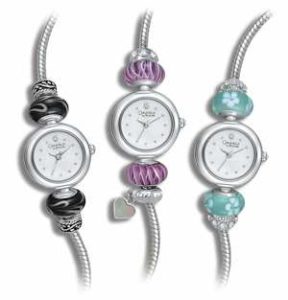 Color is the story in apparel and accessories. The exciting explosion of color use and combination in fashion has elevated interest for gem-set jewelry, where color stones have intrinsic meaning and value to people. With less of a rulebook and greater cultural influences trending globally, gems are top picks in jewelry design.
Color is the story in apparel and accessories. The exciting explosion of color use and combination in fashion has elevated interest for gem-set jewelry, where color stones have intrinsic meaning and value to people. With less of a rulebook and greater cultural influences trending globally, gems are top picks in jewelry design.
Color stones offer enormous opportunities in variety and price, creating big bang-for-the-buck when mixed with precious metals, and adding value to designs that combine non-precious materials like wood, resin, and brass.
“Fashion, historically, was more monochromatic in how we adorned,” says Michael O’Connor, jewelry stylist-to-the-stars and Reelz Channel host of “MovieStyle with Michael O’Connor.” “Women could get away with wearing all white diamond pieces, but this is no longer the case. Today’s styles are bold and colorful, and gems offer enormous return on the dollar!”
Douglas Hucker, American Gem Trade Association CEO, identifies the growth of female self-purchasers of fine jewelry, especially gem-set, as a result of the entire fashion industry integrating color and jewelry in their approach. “Jewelry is an integral part of accessories and color is what’s happening now.”
Telling of how the market has changed, O’Connor says women create different color palettes around their favorite jewelry, where it used to be the other way around. “Women are investing in nice jewelry to reinvent their look with new fashions every season” he says, hailing fine jewelry’s capacity to outlast apparel in wearability and style.
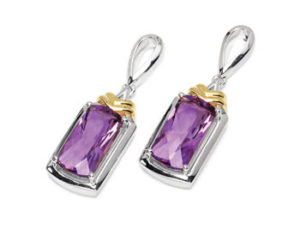 For 2013, greens and blues are popular as backdrops and foregrounds in design, with yellows, oranges and reds preferred pop colors. The tendency in jewelry is for gems that offer variety in color and price like sapphire, tourmaline, garnet, beryl, jade, quartz, and pearls. Organic shapes and slices in gemstones are popular. Moreover, fashion design directions like graphic patterns, cutout forms, texture, transparency, and mix of materials translate well in gem-set jewelry.
For 2013, greens and blues are popular as backdrops and foregrounds in design, with yellows, oranges and reds preferred pop colors. The tendency in jewelry is for gems that offer variety in color and price like sapphire, tourmaline, garnet, beryl, jade, quartz, and pearls. Organic shapes and slices in gemstones are popular. Moreover, fashion design directions like graphic patterns, cutout forms, texture, transparency, and mix of materials translate well in gem-set jewelry.
Jewelers who know what’s on the minds of their consumers, their personal taste, can best interpret catwalk to sidewalk in products relevant and desirable for their market, says retail consultant Kate Peterson, president of Performance Concepts, Montgomery Village, Maryland. To find your fashion flare, she suggests a three-prong approach: “Identify what fashion is to your customers, which could range from traditional elegance to funky chic. Make sure your staff and store represent your fashion statement. Maintain a consistent image.”
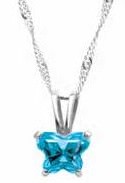 What’s great about color stones is that consumers are more open to innovative designs if they can get the feel good look at a responsible price, says Peterson, who advises jewelers offer a range of gem-set jewelry that speaks to the quality and style standards their customers expect. She reminds jewelers of the personal connections that gems also have from color preferences to the energy and mysticism associated with a mineral to reminders of people, places or times. Birthstones especially have iconic appeal in creating signature style.
What’s great about color stones is that consumers are more open to innovative designs if they can get the feel good look at a responsible price, says Peterson, who advises jewelers offer a range of gem-set jewelry that speaks to the quality and style standards their customers expect. She reminds jewelers of the personal connections that gems also have from color preferences to the energy and mysticism associated with a mineral to reminders of people, places or times. Birthstones especially have iconic appeal in creating signature style.
Color consultants suggest jewelers showcase wardrobes and themes, rather than merchandise by product category. Set scenes that help customers visualize how they can pull pieces together to create different looks. O’Connor hails color a bounty of possibilities in ever changing color combinations. He scolds jewelers for holding on to merchandise for too long and not changing showcases often enough to pique consumer curiosity, even if just by swapping existing pieces. By regularly changing displays, jewelers maintain the element of surprise, giving shoppers a reason to wander in to be delighted by the unexpected.
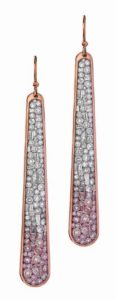 Color presents great opportunities to surprise. Consider these marketing gems:
Color presents great opportunities to surprise. Consider these marketing gems:
1. Tout your expert status as a style consultant like Lowe’s and Home Depot does with workshops aimed to empower customers. Host a fashion show or red carpet after party to dissect trends to fit customer lifestyles and budgets. Invite clients to bring in outfits to match jewelry. Connect with an image consultant to create style-focused events.
2. Use technology, lifestyle magazines and collaborative events with fashionable, non-competing retailers to finesse your style status. Mark pages of monthly fashion magazines where items similar to what you carry are featured. Keep a trends-tracking book out for consumers to reference.
3. Highlight the birthstone of the month in all its colors, as well as alternative birthstones in a variety of prices. Keep a representation of each birthstone displayed all the time to personalize a design anytime. Don’t pigeonhole what constitutes meaningful birthstone jewelry.
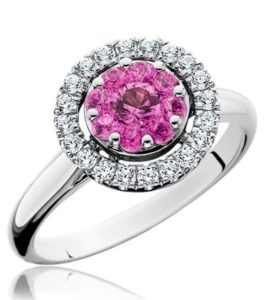 4. Promote color themes in trunk shows around certain gems like pink diamonds for breast cancer charity events, champagne diamonds for a baubles and bubbles bash, or black diamonds for a black tie affair. Charity connections sweeten the sale.
4. Promote color themes in trunk shows around certain gems like pink diamonds for breast cancer charity events, champagne diamonds for a baubles and bubbles bash, or black diamonds for a black tie affair. Charity connections sweeten the sale.
5. Sustainability and ethical business practices related to precious gems and metals are important to millennial consumers, so tout attributes like fair trade and conflict free. While the percentage of consumers who care is still marginal, it has grown from negligible in the last decade to 7 percent last year, according to the Jewelry Consumer Opinion Council.
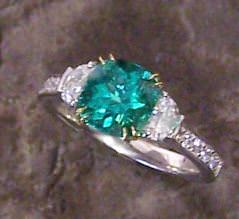 6. Share stories about the people and places associated with gems… from the hot, steamy deltas of the Amazon to the sweeping plains of East Africa, and even our own backyard in many states across the country.
6. Share stories about the people and places associated with gems… from the hot, steamy deltas of the Amazon to the sweeping plains of East Africa, and even our own backyard in many states across the country.
7. Add color to your bridal mix as centers and accents in engagement and wedding rings—color diamonds, sapphires, ruby, and emerald are favorites. This niche can distinguish jewelers from the competition and offer healthy profits in personal, hard-to-price-shop products.
Consult with your suppliers to create special in-store events and marketing programs around color that can distinguish your business from the competition.










